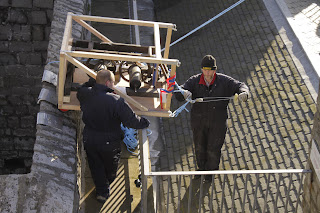Glossary - in future posts I may refer to technical terms, so for your convenience here is a short list:
Arbor - an axle
Bush - a mounted bearing for an arbor
Case - here refers to the pine box enclosing the whole movement
Count wheel - controls the number of chimes
Crutch - the arbor for the pallets
Drum - the wooden drums around which the ropes are wound
Escapement - device consisting of a pendulum, escapement wheel and pallets, designed to release one tooth of the escapement wheel at a time and to impulse the pendulum.
Fly - the set of paddles that slow the speed of the striking train
Frame - in this instance, a timber structure upon which the movement is mounted
Going train - the primary timekeeping mechanism which also drives the clock face (referred to as the “watch” by E.L. Edwardes)
Great wheel - the large gear mounted on the barrel of the going train
Lantern pinion - in place of cog teeth, a set of rods set into the rims of a pair of disks, looking rather like a little lantern
Main wheel - the large gear mounted on the barrel of the striking train
Movement - the clock mechanism
Pallets - the lugs at the end of a rocking arm, controlled by the pendulum, that check the rotation of the escapement wheel
Pinion - a small driving gear
Spring - the metal strip at the neck of the pendulum
Striking train - controls and drives the chime
Striking arm - the iron rod that pulls the bell rope
Third wheel - the principal gear in the going train
Train - sets of wheels (gears). The Castle Rushen clock has two, referred to as the going train and the striking train
Verge & foliot - an early form of escapement employing a horizontal, weighted bar
Wheel - a gear wheel



